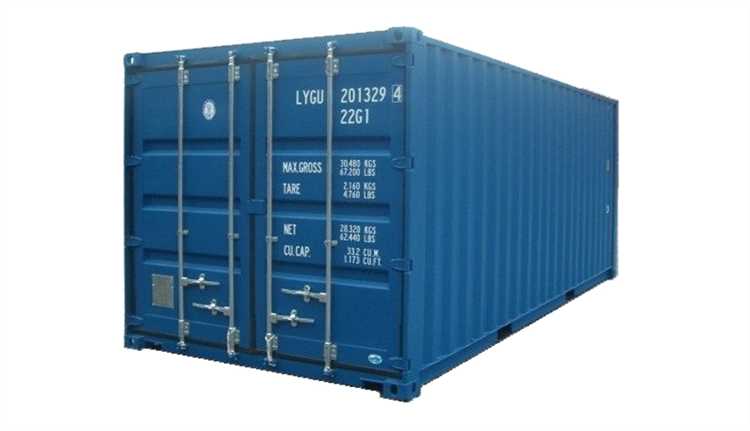The Importance of ISO Containers in Shipping
ISO containers, also referred to as shipping containers, play a vital role in the transportation industry by facilitating the safe and efficient movement of goods worldwide. These standardized containers have transformed global trade and logistics, offering streamlined and cost-effective solutions.
Key Features and Benefits of ISO Containers
ISO containers are known for their robust construction, designed to withstand the demands of transportation. Constructed from high-quality steel, these containers provide a secure environment for cargo, protecting it from external elements and ensuring its safety throughout the journey.
The standardized size of ISO containers is a significant advantage. Available in various sizes, such as 20 feet and 40 feet, they allow for easy loading and unloading from ships, trucks, and trains. This uniformity enables efficient handling, stacking, and transportation of goods, optimizing logistics operations.
Another crucial benefit of ISO containers is their compatibility with different modes of transportation. They can seamlessly transition from one mode to another, whether it’s from ship to truck or from train to ship. This intermodal capability eliminates the need for costly and time-consuming repacking, enabling the efficient movement of goods across regions and countries.
In conclusion, ISO containers are integral to the shipping industry, providing standardized, secure, and versatile solutions for transporting goods. Their durability, standardized size, and intermodal compatibility contribute to streamlined logistics and cost-effective global trade.
Types of ISO Containers and Specifications
There are different types of ISO containers available, each designed for specific types of cargo . Some examples include:
| Type | Usage |
|---|---|
| Dry Van | General cargo |
| Refrigerated | Temperature-sensitive goods |
| Tank | Liquid or gas cargo |
| Flat Rack | Over-sized or irregularly shaped cargo |
Each type of container has its own specifications in terms of dimensions, weight capacity, and special features. For example, refrigerated containers are equipped with temperature control systems to maintain the desired temperature for perishable goods.
Revolutionizing Global Trade and Logistics
ISO containers have played a significant role in revolutionizing global trade and logistics. They have standardized the shipping process, making it more efficient and cost-effective. By enabling easy and seamless transfer of goods between different modes of transport, ISO containers have made it possible for businesses to reach new markets and expand their operations globally.
Furthermore, the use of ISO containers has resulted in significant time and cost savings. The standardized size and handling procedures reduce the need for manual labor and minimize the risk of damage to the cargo . This has greatly improved supply chain efficiency and reduced transportation costs for businesses.
Conclusion
In conclusion, ISO containers have had a profound impact on the transportation industry. Their standardized size, durability, and intermodal capability make them essential for efficient and reliable transportation of goods worldwide. Whether it’s shipping general cargo , perishable goods, or specialized cargo , ISO containers provide the necessary security and convenience for businesses to thrive in the global marketplace.
ISO Container
An intermodal container, commonly known as an ISO container, serves as a standardized shipping solution that facilitates the safe and efficient transportation of goods across various modes of transportation, including ships, trains, and trucks. Engineered to withstand the rigors of long-distance journeys, these containers are designed to endure factors such as vibrations, temperature fluctuations, and the challenges associated with loading and unloading.
The utilization of ISO containers has become widespread within the global trade and logistics network due to their cost-effectiveness and reliability. Their standardized dimensions allow for optimal utilization of space, enabling efficient stacking and handling both on vessels and at terminals. To enhance security and enable easy tracking, these containers are equipped with tamper-proof locks, corrosion-resistant materials, and tracking systems.
ISO containers come in different sizes and types to accommodate diverse types of cargo. For the transportation of hazardous or dangerous goods, there are specialized containers that comply with specific regulations and certifications. Additionally, there are refrigerated containers, referred to as reefer containers, which incorporate temperature control capabilities to cater to perishable goods.
The handling and transportation of ISO containers necessitate specialized equipment and infrastructure. Container terminals, ports, and logistics companies employ dedicated cranes, forklifts, and lifting equipment to facilitate efficient loading and unloading operations. To ensure the safety of the cargo during transportation, these containers are secured using lashing and wire rope systems to prevent any shifting or damage.
To streamline customs clearance and adhere to international regulations, each ISO container is accompanied by documentation and labeling containing pertinent information such as the contents, weight, and shipping company. This documentation is essential for proper handling, transportation, and any required permits or certifications. Real-time monitoring of the container’s location and status is facilitated through the integration of satellite tracking systems.
In summary, ISO containers play a pivotal role in modern shipping practices by providing a standardized and efficient solution for the transportation of goods across diverse modes of transportation. Their robustness, security features, and versatility have made them a preferred choice for businesses engaged in global trade and logistics.
| Container Type | Description |
|---|---|
| Standard | A versatile type of ISO container that can carry general cargo . |
| High Cube | A taller version of the standard container , providing extra vertical space. |
| Flat Rack | A container with collapsible side panels , suitable for oversized cargo . |
| Tank | A container specifically designed for the transportation of liquids or gases. It has a cylindrical shape and is often made of stainless steel . |
Documentation and labeling accompany each container to ensure smooth customs clearance and compliance with international regulations. This information includes details about the container ‘s contents, weight, and shipping company. It is crucial for the proper handling and transportation of the container , including any required permits or certifications.
Satellite tracking systems provide real-time monitoring of the container ‘s location and status.

